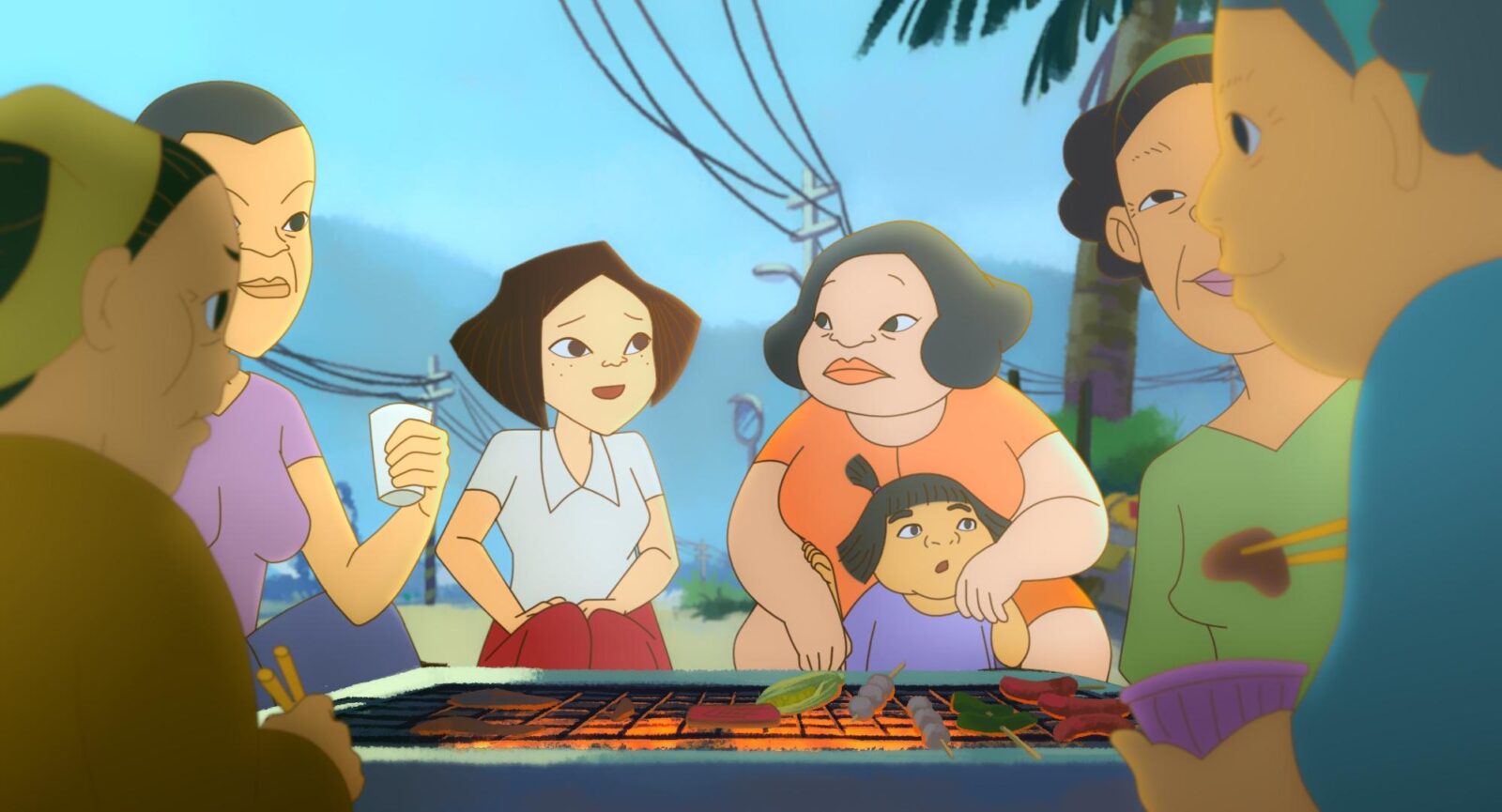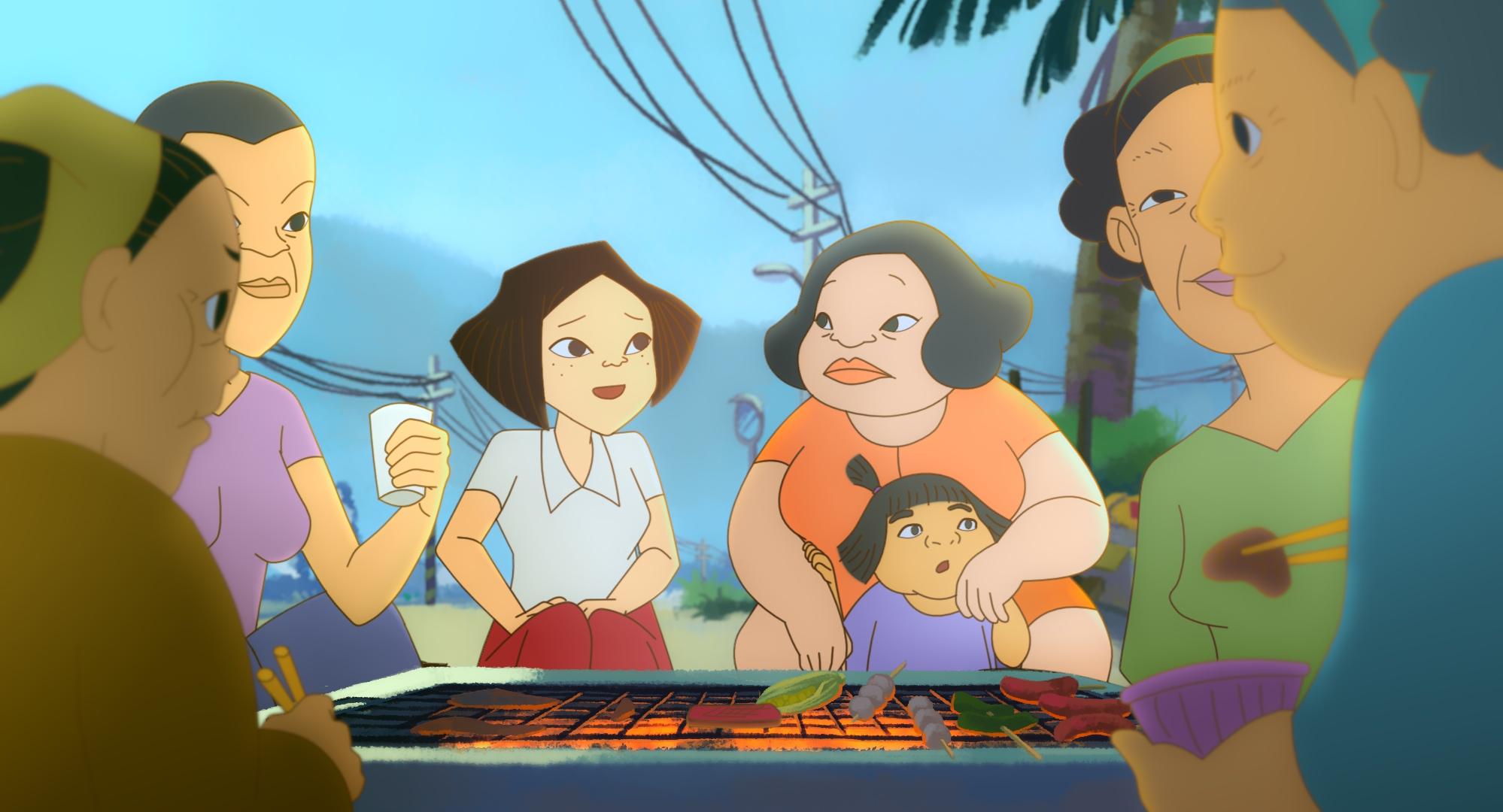
Directed by Sung Hsin Yin, On Happiness Road, released in January, is an original animation, rarely seen in recent years, that investigates Taiwanese society. Born April 5th 1975, the same date as Chiang Kai Shek’s death, Lin Shu Chi (Chi) comes from a working-class family, living on Xingfu Road (literally Happiness Road) in New Taipei. The story chronicles Chi’s growth from her elementary school years under the martial law, her dreaming about Disneyland princesses, and into adulthood facing several party alterations, chasing the American dream, and of seeking happiness through confusion and anxiety.
On Happiness Road features people from different ethnic groups on the island; Chi’s grandmother, who is of Amis (Pangcah ) aboriginal descent, her father, who has a thick Taiwanese accent, Wen Yue, who has a Chinese accent is the son of the mayor, Betty, a mixed-race girl born to a Taiwanese woman from Taichung and an American soldier, and another mixed-race child born with a Southeast Asian mother. Each character is in search of their own happiness. One of Chi’s classmates, Sheng En, drops out of elementary school to make a living and help support his family, working his way up as a mechanic and finally becoming his own boss. He runs a scooter shop, buys a building but dies when it collapses due to the combination of shoddy construction and the September 21st earthquake. The rollercoaster of events brings us back to the title itself, while the only specific answer to Chi’s question “what is happiness?” throughout the whole film is given by her grandmother. “Life can’t be too bad, if your belly’s full,” she says.
This is not only grandma’s philosophy, but the importance behind food and its meaning in On Happiness Road. For example, cousin Wen’s daughter, born in America, doesn’t eat dumplings, a typically non-American food, or Chi’s comparison of her aging mother’s loneliness to a fridge full of rotten food, and her cooking as a consolation to her elderly parents. On Happiness Road is set against Taiwan’s turbulent political history; the narrative is enriched particularly by three of these representative foods; green betel nuts, brown chocolate, and pink strawberry ice cream.
Betel Nut, Chocolate and Strawberry Ice Cream
Chi’s grandma is quite into betel nuts. She takes a long bus trip northward from her hometown Hualien to visit Chi’s family, with a basket of chicken. When Chi goes to buy betel nuts, however, she is laughed at by her schoolmates because they say only “Huan-a” (番仔, a Hokkien pejorative term usually referring to a person of aboriginal ethnicity) would eat betel nuts. Chi’s mother also asks her grandma to stop eating betel nuts in the city. Another character, Betty’s cousin, runs a betel nut stand. Since Betty’s American father has passed away, a cousin, who works in a club in Taichung, raises her up as her single mother. When Betty grows up, she ends up as a single mother too, and the betel nut stand of her cousin again becomes her shelter.
Despite coming from an underprivileged family, Betty never benefits from the social welfare system. Her exotic looking and female identity make her vulnerable to intersectional discrimination and inequalities. In the end, it is in the small betel nut stand that this misfortune is represented.
“Huan-a” as a word with pejorative connotations carries the social stigma to betel nuts. And if the betel nut business can’t sustain single mother Betty, it’s likely that she will turn to illegal activity to earn a living, which will further stigmatise the betel nut stand. While betel nut chewing is never really shown in On Happiness Road, its absence contradicts people’s accusation against it, which implies that it’s not so much the original sin of betel nuts as social conditioning that should be blamed for these issues. In contrast to the scourge of the betel nuts, Betty’s story of struggle tells us of how Taiwan’s social structure leads underprivileged people towards desperation, and how they’re trapped in a vicious circle of constant stigmatisation.
In comparison to betel nuts, chocolate reigns supreme and is more valued as a gift. When Betty as an elementary school student is about to move to Taichung, she gives Chi a piece of chocolate, mistaken as a present sent by her father. Chi went home happily with the chocolate. A single bite mixes the flavour of coca, milk, and her dreamy America: colourful Christmas lights, a smiling Statue of Liberty, and spectacular skyscrapers. With this kaleidoscopic fantasy of America, Chi gives her grandma a small piece of her cherished chocolate when she’s about to get on the bus back to Hualien. Nevertheless, when the grown-up Chi, who now has started her life in America, comes back to Taiwan for her grandmother’s funeral, putting a piece of the same chocolate in front of her grandmother’s portrait, would it taste as delicious as it used to in her childhood?
After growing up, though Chi has now moved to America, she doesn’t really find her life there as exciting as she used to fantasise. During a reunion with Betty, Chi learns that Betty and her mother were actually abandoned by her American soldier father. The chocolate sent by him turns out to be a lie to comfort a child. In the film, the chocolate brand Hisshey’s imitates the real-life Hershey company, which was a major supplier of military chocolate (chocolate served the purpose of a high-energy food ration) for American troops during World War II. Besides, at during both WWII and the Vietnam War, there were rumours about chocolate as a gift for American troops to win Asian girls’ affections. Although the story behind the chocolate is embarrassing, Chi does have some tender memories associated with it. However, when her relative finished the chocolate given to her grandma, how would this perturbed Chi react? Now that militarism takes part in this gift giving and her tender memory making, how would she share this chocolate with the next generation at her grandmother’s funeral?
Another food that is easy to associate with chocolate is strawberry ice cream. Chi’s father works in a strawberry ice cream factory in Xinzhuang (新莊), the sweet smell coming out of the chimney brings Chi a rosy fantasy. She wouldn’t realise how boring and dull the strawberry ice cream manufacture could be until she visits the factory to bring something for her father, after he is injured at work. To sustain the family, her father works at the factory, producing the ice cream out of this high-value cash crop, which is also a symbolic aspect of consumerism. In addition, pink’s strong association with femininity largely derives from the Disney princesses’ preaching about the contribution of cultural imperialism in the late 20th century.
On the other hand, Wen Yue, the mayor’s son, could go abroad to visit Disneyland when he was still an elementary school student. The film distinguishes between those who can afford something and those who cannot. By studying and working hard, Chi manages to become a member of the middle class, who could afford strawberry ice cream. The grown-up Chi watching Christmas lights in America seems to rid herself of her working class roots, with her mother engaged in domestic OEM and her father working in an unscrupulous ice cream factory. However, when Chi is considering a divorce and returning to Taiwan, the contrast of her helplessness with Wen-Yue’s running for an election, along with social reproduction, increasing economic inequality and the globalisation in the 21st century, causes her further confusion about the so-called petite bourgeoisie’s search for happiness after the Taiwan Economic Miracle.
On the Road
The warm hue and chubby characters in the animated film On Happiness Road create an impression of a naive cartoon of our childhood. But the occasional appearances of Chiang Kai-shek statues, or a scene where Chen Hsing You (the daughter of the former president Chen Shui Bian), raise plenty of issues worth discussing.
From the perspective of food, we might interpret the narrative composed with betel nuts, chocolate and strawberry ice cream in this way; there are many underprivileged families in Taiwan, like Betty’s, that depend on the betel nut business to sustain themselves. It reveals how faulty the social welfare system is, with the underprivileged excluded from the system. Like the sharing of the chocolate memory, this needs clarifying through transitional justice mechanisms, and understanding how the past becomes now; how to face the future. The class conflict represented by strawberry ice cream further points out the view of transitional justice studies in recent years that transitional justice shouldn’t be confined to civil and political rights, but also need to branch out to economic and cultural fields, dealing with rooted social issues of crony capitalism.
How will Chi raise her kid? How will these social issues be tackled? In the end, Chi’s killing-chicken-with-bare-hands grandma, after saying “happiness doesn’t last forever,” rooster-pilots away. Though there are still questions left to be answered, On Happiness Road invites the audience, some of whom may be brought up in a similar family background to that of Chi’s, others may be like Sheng En who works his way up to something, and others still resonate with Betty, born to a single mother, to pace ourselves; to think about what exactly happiness is and what kind of happiness we’re in search of.

 No products in the basket.
No products in the basket.